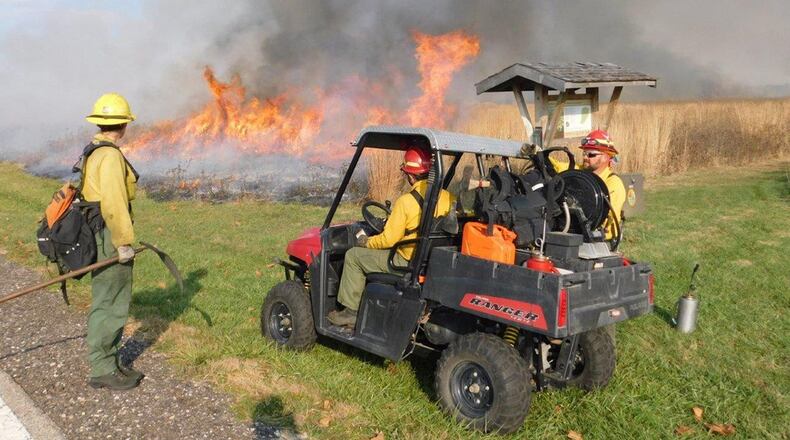“Tall grass prairies are fire dependent eco systems that need to be burned in order to thrive,” he said.
A portion of Huffman Prairie is burned every three to four years. The burn season at Wright-Patterson runs Nov. 1 through March 15. Mapped areas of Huffman Prairie are divided into four quadrants and up to one half of the quadrants are burned per season. Spring is the optimal time of the year to burn. However, if the conditions are right, a plan is in place to burn a quadrant on Nov.1.
“It’s a complex process. There are many variables involved; it’s called a prescribed burn for a variety of reasons,” said Warner.
A prescription is developed, plans are formulated, waivers and permits authorized, and coordination with nearby organizations and facilities is accomplished.
There are many conditions taken into consideration before a burn can take place. Some of the factors considered are temperature, humidity, wind direction, the atmosphere, the ceiling height and the schedule of Wright-Patterson’s flying mission.
“It gets really complicated; all aspects have to be inline before we can start the burn,” Warner explained.
For many years, the 88th Civil Engineering Natural Resources Division has partnered with the U.S. Fish and Wildlife Service to conduct burns. The two organizations have similar responsibilities. Both groups oversee threatened, endangered and invasive species, prairie and flood plains management, fish, wild life and wetlands management.
When the USFWS comes to Wright-Patterson to assist in a prescribed burn, it supplies the wildland firefighters and the specialized equipment needed to burn. WPAFB fight fighters are on standby to assist and for emergencies.
“There are a lot of differences between structural firefighters and wildland firefighters,” said Warner.
The USFWS are wildland firefighters and the Wright-Patterson firefighters are structural firefighters. Many aspects of their training and certification processes are not alike.
“Prescribed burns are a unique management tool used for conservation of a unique habitat,” Warner said.
Because of the history surrounding Huffman Prairie and the interest to the public, the 88 Civil Engineering division has agreements with the National Park Service and the Dayton Five Rivers MetroParks. The organizations work closely with one another when scheduling burns.
Approximately 100 acres of tall grass prairie are accessible to the general public through Gate 16A off of State Route 444.
For more information about Huffman Prairie, visit www.nps.gov
About the Author
